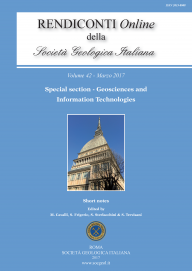
Stima robusta e generalizzata della rugosità superficiale per la caratterizzazione geomorfometrica del territorio
Sebastiano Trevisani (a)
(a) Dipartimento DACC, Università IUAV di Venenzia, Italy. Corresponding author e-mail: strevisani@iuav.it.
DOI: https://doi.org/10.3301/ROL.2017.06
Volume: 42/2017
Pages: 27-29
Abstract
Robust and generalized roughness evaluation for landscape geomorphometric characterization. In this work, some potentialities and characteristics of a new class of geostatiscal-based roughness indexes are presented. The proposed indexes rely on MAD estimator (median absolute differences); MAD, with its implementation based on local kernels, permits the derivation of a wide set of robust and customizable geomorphometric indexes, capable to highlight specific aspects of surface texture. Surface roughness, similarly to images texture, is a complex spatial property covering many aspects that cannot be synthetized by a single spatial index; from this viewpoint, it is not surprising the wide set of roughness indexes proposed in the scientific literature. Solid earth surface roughness is characterized by a high spatial-statistical complexity; hence, there is the need of spatial-statistical indexes capable to deal with this complexity. Geostatistical-based image/surface texture indexes have been proposed since the '80s and '90s of the past century, both in the field of remote sensing as well as in geomorphometry. Moreover, the surface roughness characterization has new interesting potentials in applied geosciences given the increasing availability of high-resolution Digital Terrain Models (HRDTMs) (pixel size of 2 m or less). In fact, the local fine-scale morphology can furnish relevant information on the related geomorphic processes and factors, with important reflections on many disciplines (applied geology, geomorphology, structural geology, ecology, etc.).
Accordingly, MAD has been specifically developed for the analysis of HR- DTMs, as an improvement of variogram-based roughness indexes; in particular, MAD has been designed for the analysis of spatial data characterized by the presence of signal noise, abrupt changes in spatial variability and non-stationarity. The flexibility in the implementation of bespoke roughness indexes, capable to outline different aspects of surface roughness, opens new potentialities in landscape analysis.
Keywords
DTM ad alta risoluzione, median absolute differences, pericoli naturali, rugosit. flusso-direzionale, variogramma.
Get Full Text